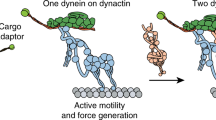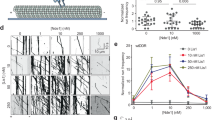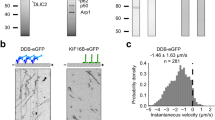Abstract
Cytoplasmic dynein is the primary molecular motor responsible for transport of vesicles, organelles, proteins and RNA cargoes from the periphery of the cell towards the nucleus along the microtubule cytoskeleton of eukaryotic cells. Dynactin, a large multi-subunit activator of dynein, docks cargo to the motor and may enhance dynein processivity. Here, we show that individual fluorescently labelled dynein–dynactin complexes exhibit bidirectional and processive motility towards both the plus and minus ends of microtubules. The dependence of this activity on substrate ATP concentration, nucleotide analogues and inhibitors suggests that bidirectional motility is an active energy-transduction property of dynein–dynactin motor mechano-chemistry. The unique motility characteristics observed may reflect the flexibility of the dynein structure that leads to an enhanced ability to navigate around obstacles in the cell.
This is a preview of subscription content, access via your institution
Access options
Subscribe to this journal
Receive 12 print issues and online access
$209.00 per year
only $17.42 per issue
Buy this article
- Purchase on Springer Link
- Instant access to full article PDF
Prices may be subject to local taxes which are calculated during checkout





Similar content being viewed by others
References
Paschal, B. M. & Vallee, R. B. Retrograde transport by the microtubule-associated protein MAP 1C. Nature 330, 181–183 (1987).
Burgess, S. A., Walker, M. L., Sakakibara, H., Knight, P. J. & Oiwa, K. Dynein structure and power stroke. Nature 421, 715–718 (2003).
Ogawa, K. Four ATP-binding sites in the midregion of the β heavy chain of dynein. Nature 352, 643–645 (1991).
Gibbons, I. R. et al. Photosensitized cleavage of dynein heavy chains: Cleavage at the 'V1 site' by irradiation at 365 nm in the presence of ATP and vanadate. J. Biol. Chem. 262, 2780–2786 (1987).
Kon, T., Nishiura, M., Ohkura, R., Toyoshima, Y. Y. & Sutoh, K. Distinct functions of nucleotide-binding/hydrolysis sites in the four AAA modules of cytoplasmic dynein. Biochemistry 43, 11266–11274 (2004).
Takahashi, Y., Edamatsu, M. Toyoshima, Y. Y. Multiple ATP-hydrolyzing sites that potentially function in cytoplasmic dynein. Proc. Natl Acad. Sci. USA 101, 12865–12869 (2004).
Schroer, T. A. Dynactin. Annu. Rev. Cell Dev. Biol. 20, 759–779 (2004).
Schroer, T. A. & Sheetz, M. P. Two activators of microtubule-based vesicle transport. J. Cell Biol. 115, 1309–1318 (1991).
Waterman-Storer, C. M. et al. The interaction between cytoplasmic dynein and dynactin is required for fast axonal transport. Proc. Natl Acad. Sci. USA 94, 12180–12185 (1997).
Levy, J. R. et al. A motor neuron disease-associated mutation in p150Glued perturbs dynactin function and induces protein aggregation. J. Cell Biol. 172, 733–745 (2006).
Puls, I. et al. Mutant dynactin in motor neuron disease. Nature Genet. 33, 455–456 (2003).
King, S. J. & Schroer, T. A. Dynactin increases the processivity of the cytoplasmic dynein motor. Nature Cell Biol. 2, 20–24 (2000).
Wang, Z. & Sheetz, M. P. One-dimensional diffusion on microtubules of particles coated with cytoplasmic dynein and immunoglobulins. Cell Struct. Funct. 24, 373–383 (1999).
Ishii, Y., Nishiyama, M. & Yanagida, T. Mechano-chemical coupling of molecular motors revealed by single molecule measurements. Curr. Protein Pept. Sci. 5, 81–87 (2004).
Kon, T., Mogami, T., Ohkura, R., Nishiura, M. & Sutoh, K. ATP hydrolysis cycle-dependent tail motions in cytoplasmic dynein. Nature Struct. Mol. Biol. 12, 513–519 (2005).
Mallik, R., Carter, B. C., Lex, S. A., King, S. J. & Gross, S. P. . Cytoplasmic dynein functions as a gear in response to load. Nature 427, 649–652 (2004).
LaMonte, B. H. et al. Disruption of dynein/dynactin inhibits axonal transport in motor neurons causing late-onset progressive degeneration. Neuron 34, 715–727 (2002).
Bingham, J. B., King, S. J. & Schroer, T. A. Purification of dynactin and dynein from brain tissue. Methods Enzymol. 298, 171–184 (1998).
Vale, R. D. et al. Direct observation of single kinesin molecules moving along microtubules. Nature 380, 451–453 (1996).
Schafer, D. A., Gill, S. R., Cooper, J. A., Heuser, J. E. & Schroer, T. A. Ultrastructural analysis of the dynactin complex: An actin-related protein is a component of a filament that resembles F-actin. J. Cell Biol. 126, 403–412 (1994).
Euteneuer, U., Koonce, M. P., Pfister, K. K. & Schliwa, M. An ATPase with properties expected for the organelle motor of the giant amoeba, Reticulomyxa. Nature 332, 176–178 (1988).
Mallik, R., Petrov, D., Lex, S. A., King, S. J. & Gross, S. P. Building complexity: An in vitro study of cytoplasmic dynein with in vivo implications. Curr. Biol. 15, 2075–2085 (2005).
Wang, Z., Khan, S. & Sheetz, M. P. Single cytoplasmic dynein molecule movements: Characterization and comparison with kinesin. Biophys. J. 69, 2011–2023 (1995).
Wang, Z. & Sheetz, M. P. The C-terminus of tubulin increases cytoplasmic dynein and kinesin processivity. Biophys. J. 78, 1955–1964 (2000).
Okada, Y. & Hirokawa, N. A processive single-headed motor: kinesin superfamily protein KIF1A. Science 283, 1152–1157 (1999).
Shimizu, T., Toyoshima, Y. Y., Edamatsu, M. & Vale, R. D. Comparison of the motile and enzymatic properties of two microtubule minus-end-directed motors, ncd and cytoplasmic dynein. Biochemistry 34, 1575–1582 (1995).
Hersch, G. L., Burton, R. E., Bolon, D. N., Baker, T. A. & Sauer, R. T. Asymmetric interactions of ATP with the AAA+ ClpX6 unfoldase: Allosteric control of a protein machine. Cell 121, 1017–1027 (2005).
Mancini, E. J. et al. Atomic snapshots of an RNA packaging motor reveal conformational changes linking ATP hydrolysis to RNA translocation. Cell 118, 743–755 (2004).
Holzbaur, E. L. & Johnson, K. A. Microtubules accelerate ADP release by dynein. Biochemistry 28, 7010–7016 (1989).
Culver-Hanlon, T. L., Lex, S. A., Stephens, A. D., Quintyne, N. J. & King, S. J. A microtubule-binding domain in dynactin increases dynein processivity by skating along microtubules. Nature Cell Biol. 8, 264–270 (2006).
Waterman-Storer, C. M., Karki, S. & Holzbaur, E. L. F. The p150Glued component of the dynactin complex binds to both microtubules and the actin-related protein centractin (Arp-1). Proc. Natl Acad. Sci. USA 92, 1634–1638 (1995).
Deacon, S. W. et al. Dynactin is required for bidirectional organelle transport. J. Cell Biol. 160, 297–301 (2003).
Lasek, R. J. & Brady, S. T. Attachment of transported vesicles to microtubules in axoplasm is facilitated by AMP–PNP. Nature 316, 645–647 (1985).
Murray, J. W., Bananis, E. & Wolkoff, A. W. Reconstitution of ATP-dependent movement of endocytic vesicles along microtubules in vitro: An oscillatory bidirectional process. Mol. Biol. Cell 11, 419–433 (2000).
Vale, R. D., Reese, T. S. & Sheetz, M. P. Identification of a novel force-generating protein, kinesin, involved in microtubule-based motility. Cell 42, 39–50 (1985).
He, Y. et al. Role of cytoplasmic dynein in the axonal transport of microtubules and neurofilaments. J. Cell Biol. 168, 697–703 (2005).
Ling, S.-C., Fahrner, P. S., Greenough, W. T. & Gelfand, V. I. Transport of Drosophila fragile X mental retardation protein-containing ribonucleoprotein granules by kinesin-1 and cytoplasmic dynein. Proc. Natl Acad. Sci. USA 101, 17428–17433 (2004).
Nan, X., Sims, P. A., Chen, P. & Xie, X. S. Observation of individual microtubule motor steps in living cells with endocytosed quantum dots. J. Phys. Chem. B 109, 24220–24224 (2005).
Gross, S. P. et al. Interactions and regulation of molecular motors in Xenopus melanophores. J. Cell Biol. 156, 855–865 (2002).
Karki, S. & Holzbaur, E. L. F. Affinity chromatography demonstrates a direct binding between cytoplasmic dynein and the dynactin complex. J. Biol. Chem. 270, 28806–28811 (1995).
Acknowledgements
This work was supported by a National Institutes of Health (NIH) project program grant (P01–AR–051174) to the Pennsylvania Muscle Institute, by an ALS Association grant to E.L.F.H., and J.L.R. is supported by an NIH NRSA grant (1F32GM075754–01). The authors also thank A. Loh, R. Kudaravalli, H. Pham, W. Zhou and M. Tokito.
Author information
Authors and Affiliations
Corresponding author
Ethics declarations
Competing interests
The authors declare no competing financial interests.
Supplementary information
Supplementary Information
Supplementary Figures S1, S2, S3 and S4 (PDF 2861 kb)
Supplementary Information
Supplementary Movie S1 (AVI 210 kb)
Rights and permissions
About this article
Cite this article
Ross, J., Wallace, K., Shuman, H. et al. Processive bidirectional motion of dynein–dynactin complexes in vitro. Nat Cell Biol 8, 562–570 (2006). https://doi.org/10.1038/ncb1421
Received:
Accepted:
Published:
Issue Date:
DOI: https://doi.org/10.1038/ncb1421
This article is cited by
-
Somatic mutation of DNAH genes implicated higher chemotherapy response rate in gastric adenocarcinoma patients
Journal of Translational Medicine (2019)
-
Cargo adaptors regulate stepping and force generation of mammalian dynein–dynactin
Nature Chemical Biology (2019)
-
Step Sizes and Rate Constants of Single-headed Cytoplasmic Dynein Measured with Optical Tweezers
Scientific Reports (2018)
-
Self-propelling vesicles define glycolysis as the minimal energy machinery for neuronal transport
Nature Communications (2016)
-
Nanoparticle-assisted optical tethering of endosomes reveals the cooperative function of dyneins in retrograde axonal transport
Scientific Reports (2015)



